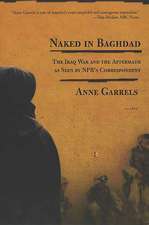Sousveillance, Media and Strategic Political Communication: Iraq, USA, UK
Autor Dr. Vian Bakiren Limba Engleză Paperback – 28 iul 2010
| Toate formatele și edițiile | Preț | Express |
|---|---|---|
| Paperback (1) | 192.55 lei 6-8 săpt. | |
| Bloomsbury Publishing – 28 iul 2010 | 192.55 lei 6-8 săpt. | |
| Hardback (1) | 715.26 lei 6-8 săpt. | |
| Bloomsbury Publishing – 28 iul 2010 | 715.26 lei 6-8 săpt. |
Preț: 192.55 lei
Preț vechi: 222.69 lei
-14% Nou
Puncte Express: 289
Preț estimativ în valută:
36.85€ • 40.01$ • 30.95£
36.85€ • 40.01$ • 30.95£
Carte tipărită la comandă
Livrare economică 23 aprilie-07 mai
Preluare comenzi: 021 569.72.76
Specificații
ISBN-13: 9780826430090
ISBN-10: 0826430090
Pagini: 256
Ilustrații: 8
Dimensiuni: 150 x 226 x 18 mm
Greutate: 0.4 kg
Editura: Bloomsbury Publishing
Colecția Continuum
Locul publicării:New York, United States
ISBN-10: 0826430090
Pagini: 256
Ilustrații: 8
Dimensiuni: 150 x 226 x 18 mm
Greutate: 0.4 kg
Editura: Bloomsbury Publishing
Colecția Continuum
Locul publicării:New York, United States
Caracteristici
Vividly demonstrates the impact of media form on strategic political communication and politics in the teletechnological environment
Cuprins
Acknowledgements
Glossary
Chapter 1 - Web-based Participatory Media, Strategic Political Communication and Sousveillance
- Web-based Participatory Media and Strategic Political Communication
- Strategic Political Communication in the West and the Middle East
- From Surveillance to Sousveillance
- The Case Studies
Chapter 2 - Bearing Witness during the 2003 Iraq War: Embeds and Bloggers
- Introduction
- Political Environment
- Media Environment
- Identifying with the Embeds
- Identifying with the Iraqis: Salam Pax
- Conclusion
Chapter 3 - Controlling the Military's Image: Abu Ghraib (2004) and Is this the Way to Armadillo (2005)
- Introduction
- Political Environment
- Media Environment
- Abu Ghraib: The Downward Spiral of the Military's Image
- Is this the Way to Armadillo?
- Conclusion
Chapter 4 - Controlling Saddam Hussein's Image: His Capture (2003) and Execution (2006)
- Introduction
- Political Environment
- Media Environment
- Controlled Image: The Capture of Saddam Hussein
- Losing Control: The Execution of Saddam Hussein
- Conclusion
Chapter 5 - Sousveillance and Strategic Political Communication: Developments & Implications
- Introduction
- Political Environment 2007-9
- Media Environment 2007-9
- Towards Sousveillance Cultures
- Implications for Strategic Political Communication
- The Future?
References
Index
Glossary
Chapter 1 - Web-based Participatory Media, Strategic Political Communication and Sousveillance
- Web-based Participatory Media and Strategic Political Communication
- Strategic Political Communication in the West and the Middle East
- From Surveillance to Sousveillance
- The Case Studies
Chapter 2 - Bearing Witness during the 2003 Iraq War: Embeds and Bloggers
- Introduction
- Political Environment
- Media Environment
- Identifying with the Embeds
- Identifying with the Iraqis: Salam Pax
- Conclusion
Chapter 3 - Controlling the Military's Image: Abu Ghraib (2004) and Is this the Way to Armadillo (2005)
- Introduction
- Political Environment
- Media Environment
- Abu Ghraib: The Downward Spiral of the Military's Image
- Is this the Way to Armadillo?
- Conclusion
Chapter 4 - Controlling Saddam Hussein's Image: His Capture (2003) and Execution (2006)
- Introduction
- Political Environment
- Media Environment
- Controlled Image: The Capture of Saddam Hussein
- Losing Control: The Execution of Saddam Hussein
- Conclusion
Chapter 5 - Sousveillance and Strategic Political Communication: Developments & Implications
- Introduction
- Political Environment 2007-9
- Media Environment 2007-9
- Towards Sousveillance Cultures
- Implications for Strategic Political Communication
- The Future?
References
Index
Recenzii
The concept of 'sousveillance' proves to be an intriguingly provocative entry point into a fascinating set of debates. Vian Bakir's inspired critique delves deeply into a wide range of pressing issues at the heart of current innovations in participatory media. --Professor Stuart Allan, Bournemouth University, UK
This is a scholarly, well-researched book that casts new light on one of the most important aspects of the media of conflict, the rise of voices from below. Vian Bakir has put together a series of meticulously detailed case studies on how the use of social media changed during the US and UK invasion and occupation of Iraq. By placing individuals' blog entries and digital images against a close reading of the political and media contexts in the west and Iraq, she takes us well beyond a celebration of sousveillance to a critical appreciation of the role of social media in both disrupting and furthering the political control of communication. --Donald Matheson, senior lecturer in media and communication, University of Canterbury, New Zealand
A timely and much-needed study on the challenges that participatory media pose to strategic political communication, which offers a novel comparative perspective on Western and Middle Eastern cases as well as original theoretical insights on the social dialectics of power and resistance- surveillance and sousveillance. --Lilie Chouliaraki, Department of Media and Communications, London School of Economics and Political Science
Mentioned on the RSA Conference blog.
[Bakir's] case studies of the respective developments in the Iraq War since 2003... are carefully argued, insightful and revealing. They should inevitably become required readings on the mediatisation of international relations as they diligently illuminate the underlying complex and at times ambiguous dynamics.
"Sousveillance, Media and Strategic Political Communication provides an interesting look at how Web 2.0 generates an intensification of the notion of sousveillance and the rise of sousveillance cultures. For anyone who wants an understanding of how media worked and continues to operate in the Iraq conflict, Sousveillance is required reading."-Ben Rothke, author of Computer Security: 20 Things Every Employee Should Know
This is a scholarly, well-researched book that casts new light on one of the most important aspects of the media of conflict, the rise of voices from below. Vian Bakir has put together a series of meticulously detailed case studies on how the use of social media changed during the US and UK invasion and occupation of Iraq. By placing individuals' blog entries and digital images against a close reading of the political and media contexts in the west and Iraq, she takes us well beyond a celebration of sousveillance to a critical appreciation of the role of social media in both disrupting and furthering the political control of communication. --Donald Matheson, senior lecturer in media and communication, University of Canterbury, New Zealand
A timely and much-needed study on the challenges that participatory media pose to strategic political communication, which offers a novel comparative perspective on Western and Middle Eastern cases as well as original theoretical insights on the social dialectics of power and resistance- surveillance and sousveillance. --Lilie Chouliaraki, Department of Media and Communications, London School of Economics and Political Science
Mentioned on the RSA Conference blog.
[Bakir's] case studies of the respective developments in the Iraq War since 2003... are carefully argued, insightful and revealing. They should inevitably become required readings on the mediatisation of international relations as they diligently illuminate the underlying complex and at times ambiguous dynamics.
"Sousveillance, Media and Strategic Political Communication provides an interesting look at how Web 2.0 generates an intensification of the notion of sousveillance and the rise of sousveillance cultures. For anyone who wants an understanding of how media worked and continues to operate in the Iraq conflict, Sousveillance is required reading."-Ben Rothke, author of Computer Security: 20 Things Every Employee Should Know















